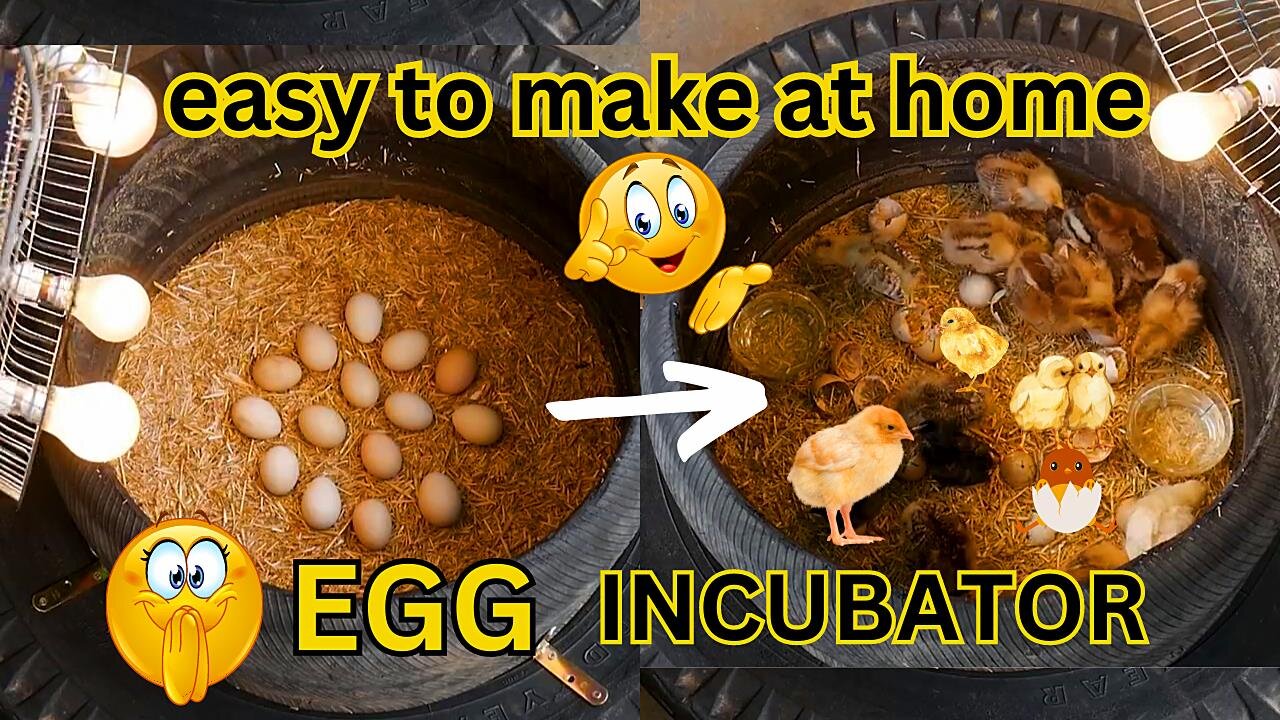Premium Only Content

HOW TO MAKE EGG INCUBATOR || HOMEMADE INCUBATOR || HATCHING CHICKEN EGGS || DIY INCUBATOR PROJECT
I make these videos so that you can financially support to my family. For this you can become my member and contribute to the support because we need yours's support disparately.
Many Many Thanks.
Link: https://patreon.com/MuhammadAsifMughal
Contact: mcmbryon@gmail.com
Creating an egg incubator using recycled materials like an old tire and an electric bulb can be an interesting and sustainable project. Please note that building an incubator involves working with electrical components, and safety precautions should be taken. Also, keep in mind that successful egg incubation requires precise temperature and humidity control.
Here's a basic guide to help you make a simple egg incubator using recycled materials:
Materials:
Old tire
Electric bulb (preferably with a low wattage, like 25-40 watts)
Socket and electrical wiring
Thermostat (optional but highly recommended for temperature control)
Hygrometer (optional for measuring humidity)
Ventilation system (small fan or openings for airflow)
Egg tray or container
Insulation material (e.g., foam or Styrofoam)
Thermometer
Recycled materials for decoration (optional)
Instructions:
Prepare the Tire:
Clean the old tire thoroughly.
Cut the tire in half horizontally to create two circular halves. The bottom half will be the base of your incubator.
Create the Incubator Structure:
Place the egg tray or container in the center of the tire half to hold the eggs.
Use insulation material to line the inside of the tire to help maintain a stable temperature.
Install the Light Bulb:
Install the electric bulb socket on the inner side of the top half of the tire.
Place the low-wattage bulb inside the socket. This will act as the heat source.
Temperature Control:
If using a thermostat, connect it to the electric bulb to control the temperature. Follow the manufacturer's instructions for installation.
If not using a thermostat, monitor the temperature manually with a thermometer. Adjust the distance between the bulb and the eggs to regulate the temperature.
Humidity Control:
If using a hygrometer, place it inside the incubator to monitor humidity.
You can increase humidity by placing a small water container inside the incubator.
Ventilation:
Ensure proper ventilation to maintain fresh air circulation. You can create small openings or use a small fan for this purpose.
Decoration (Optional):
Use recycled materials to decorate the outside of the incubator, making it visually appealing.
Testing:
Before placing eggs inside, test the incubator's temperature and humidity over a period of time to ensure stability.
Remember, maintaining a constant temperature and humidity is crucial for successful egg incubation. Additionally, always prioritize safety when working with electrical components. If you're unsure or uncomfortable with any part of the process, seek assistance from someone with experience in electronics.
-
 2:34:02
2:34:02
Barry Cunningham
7 hours agoLISA COOK | ADAM SCHIFF | LETITIA JAMES | ARE THEY BEING SACRIFICED BY THE DEEP STATE?
97.1K53 -
 1:36:19
1:36:19
Flyover Conservatives
15 hours agoOnly 17% of Millennials Hit These 5 Adult Milestones—Why?; What If Childhood Trauma Is Behind Your Health Problems? - Dr. Troy Spurrill | FOC Show
37.1K4 -
 4:49:04
4:49:04
HogansAlleyHero
17 hours ago💥CHASING DOPAMINE💥✅TRUMP SAYS BATTLEFIELD IS THE BEST✅
47.7K3 -
 1:57:40
1:57:40
MattMorseTV
8 hours ago $12.55 earned🔴Trump just SHATTERED the PROJECTIONS.🔴
58.4K50 -
 2:32:19
2:32:19
megimu32
6 hours agoOTS: From Star Search to Superstardom
41.5K4 -
 1:56:21
1:56:21
Joker Effect
5 hours agoInterviewing GREENMAN! Looks like he is coming to Rumble! Let's give him a warm welcome! REAL TALENT
25.6K1 -
 1:07:21
1:07:21
Anthony Rogers
12 hours agoEpisode 380 - Is Pain All In Your Head?
18K3 -
 1:46:17
1:46:17
Glenn Greenwald
10 hours agoGlenn Takes Your Questions on Censorship, Epstein, and More; DNC Rejects Embargo of Weapons to Israel with Journalist Dave Weigel | SYSTEM UPDATE #505
119K8 -
 3:26:34
3:26:34
Jokeuhl Gaming and Chat
11 hours agoHelldivers 2 - Spreading Democracy w/ Ryker
14K1 -
 27:47
27:47
Stephen Gardner
7 hours ago🚨BREAKING: Trump FURIOUS Over Kamala’s Latest Move – SHOCKING Details!
19.5K83